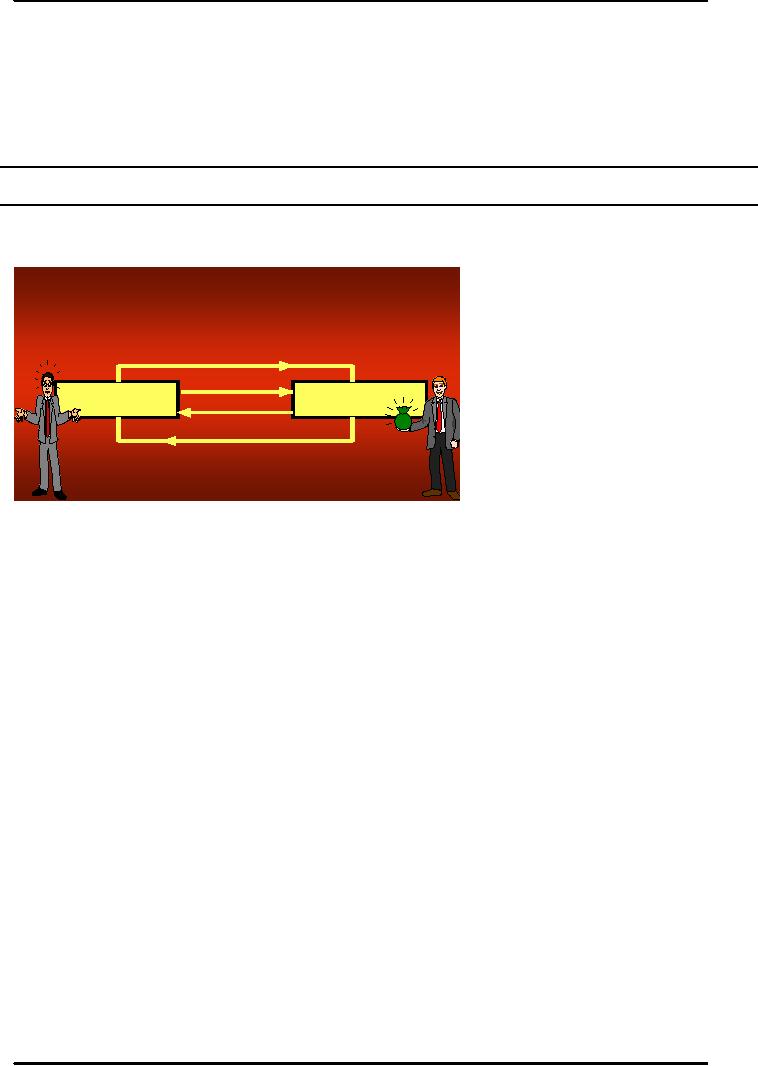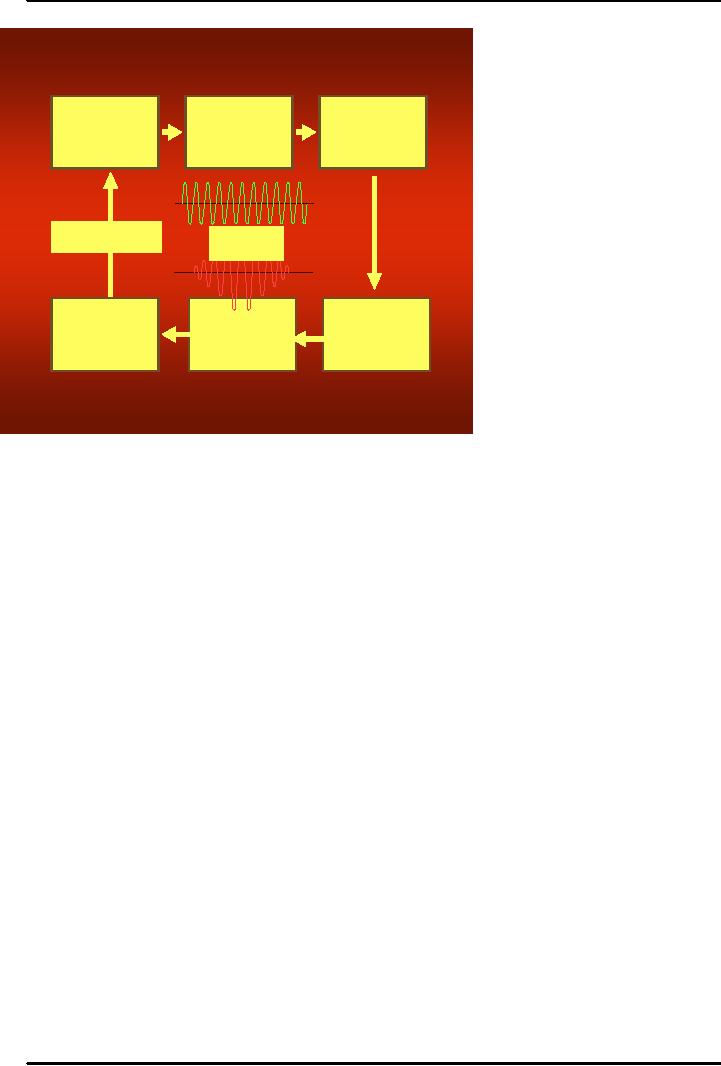 |

Principles
of Marketing MGT301
VU
Lesson
32
Lesson
overview and learning objectives:
This
Lesson is about integrating
the firm's marketing communication in
order to generate
synergies
between
the various elements of communications
package. It gives an overview of
integrated
marketing
communication, communication process,
different methods to set promotional
budget
and
various promotional tools.
PROMOTION
THE 4TH P OF MARKETING MIX
A.
The
Marketing Communications
Modern
marketing calls for more
than just developing a good
product, pricing it attractively,
and
making
it available to target
S
im p le M a r k e tin g
customers.
Companies must also
communicate
with current and
S
y s te m
prospective
customers, and what
they
communicate should not
be
C
o m m u n ic a tio n
left
to chance. For
most
P
r o d u c t/S e r v ic e
companies,
the question is not
P
r o d u c e r /S e lle r
C
onsum er
whether
to communicate, but
M
oney
how
much to spend and in
what
ways.
All
of
their
Feedback
communications
efforts must be
blended
into a consistent and
coordinated
communications
program.
As
shown in the fig, completion
of marketing process requires something
of value with
both
producer and customer that
should be communicated with
each other for performing
the
exchange
process.
B.
The Marketing Communications
Mix.
A
company's total marketing communications
mix--also called its promotion
mix consists of the
specific
blend of advertising, personal selling,
sales promotion, public relations,
and direct-
marketing
tools that the company
uses to pursue its advertising and marketing
objectives.
Definitions
of the five major promotion
tools follow:
Advertising:
Any paid form of nonpersonal
presentation and promotion of ideas,
goods, or
services
by
an
identified
sponsor.
Personal
selling: Personal presentation by the
firm's sales force for
the purpose of making sales
and
building
customer
relationships.
Sales
promotion: Short-term incentives to
encourage the purchase or
sale of a product or
service.
Public
relations: Building good relations with
the company's various publics by obtaining
favorable
publicity,
building up a good corporate image,
and handling or heading off
unfavorable rumors,
stories,
and
events.
Direct
marketing: Direct connections with
carefully targeted individual
consumers to both
obtain
an
immediate response and
cultivate lasting customer relationships--the
use of telephone, mail,
fax,
e-mail, the Internet, and
other tools to communicate
directly with specific
consumers.
Each
category involves specific
tools. For example, advertising includes
print, broadcast,
outdoor,
and
other forms. Personal selling includes
sales presentations, trade shows,
and incentive
programs.
Sales promotion includes
point-of-purchase displays, premiums,
discounts, coupons,
159

Principles
of Marketing MGT301
VU
specialty
advertising, and demonstrations. Direct marketing
includes catalogs, telemarketing,
fax,
kiosks,
the Internet, and more.
Thanks to technological breakthroughs,
people can now
communicate
through traditional media
(newspapers, radio, telephone, television), as
well as
through
newer media forms (fax
machines, cellular phones, pagers,
and computers). The
new
technologies
have encouraged more
companies to move from mass
communication to more
targeted
communication and one-to-one
dialogue.
C.
Integrated Marketing
Communications
During
the past several decades,
companies around the world
have perfected the art of
mass
marketing--selling
highly standardized products to
masses of customers. In the process,
they have
developed
effective mass-media advertising techniques to
support their mass-marketing
strategies.
These
companies routinely invest
immense amount of money in
the mass media, reaching
tens of
millions
of customers with a single ad.
However, as we move into the
twenty-first century,
marketing
managers face some new
marketing communications
realities.
D.
The Changing Communications
Environment
Two
major factors are changing
the face of today's marketing
communications. First, as
mass
markets
have fragmented, marketers are
shifting away from mass
marketing. More and more,
they
are
developing focused marketing programs
designed to build closer relationships
with customers
in
more narrowly defined micro
markets. Second, vast
improvements in information
technology
are
speeding the movement toward
segmented marketing. Today's information
technology helps
marketers
to keep closer track of customer
needs--more information about consumers
at the
individual
and household levels is
available than ever before.
New technologies also provide
new
communications
avenues for reaching smaller customer
segments with more tailored
messages.
The
shift from mass marketing to
segmented marketing has had a dramatic
impact on marketing
communications.
Just as mass marketing gave
rise to a new generation of
mass-media
communications,
the shift toward one-to-one
marketing is spawning a new generation of
more
specialized
and highly targeted
communications efforts.
Given
this new communications
environment, marketers must
rethink the roles of various
media
and
promotion mix tools.
Mass-media advertising has long dominated
the promotion mixes
of
consumer
product companies. However,
although television, magazines, and
other mass media
remain
very important, their dominance is
now declining. Market fragmentation
has resulted in
media
fragmentation--in an explosion of more
focused media that better
match today's targeting
strategies.
More generally, advertising appears to be
giving way to other elements of
the promotion
mix.
In the glory days of mass
marketing, consumer product companies spent
the lion's share of
their
promotion budgets on mass-media
advertising. Today, media advertising
captures only about
26
percent of total promotion spending.
The rest goes to various
sales promotion activities,
which
can
be focused more effectively on
individual consumer and trade
segments. They are using
a
richer
variety of focused communication
tools in an effort to reach
their diverse target
markets. In
all,
companies are doing less
broadcasting and more
narrowcasting.
E.
The Need for Integrated
Marketing Communications
The
shift from mass marketing to
targeted marketing, and the corresponding
use of a richer
mixture
of communication channels and promotion
tools, poses a problem for
marketers.
Consumers
are being exposed to a
greater variety of marketing
communications from and
about
the
company from a broader array
of sources. However, customers don't
distinguish between
message
sources the way marketers do. In
the consumer's mind, advertising messages
from
different
media such as television, magazines, or
online sources blur into
one. Messages delivered
via
different promotional approaches--such as advertising,
personal selling, sales
promotion,
public
relations, or direct marketing--all become
part of a single message
about the company.
Conflicting
messages from these
different sources can result
in confused company images
and
brand
positions.
160

Principles
of Marketing MGT301
VU
All
too often, companies fail to
integrate their various communications
channels. The result is a
hodgepodge
of communications to consumers. Mass
advertisements say one thing, a
price
promotion
sends a different signal, a
product label creates still
another message, company
sales
literature
says something altogether different,
and the company's Web site
seems out of sync
with
everything
else.
The
problem is that these
communications often come
from different company
sources.
Advertising
messages are planned and
implemented by the advertising department
or advertising
agency.
Sales management develops
personal selling communications. Other
functional specialists
are
responsible for public relations,
sales promotion, direct marketing, online
sites, and other
forms
of
marketing communications. Recently, such
functional separation has
been a major problem
for
many
companies and their Internet
communications activities, which are
often split off
into
separate
organizational units. In the past, no one
person was responsible for
thinking through the
communication
roles of the various promotion
tools and coordinating the
promotion mix. Today,
however,
more companies are adopting
the concept of integrated marketing
communications
(IMC).
The
IMC solution calls for recognizing
all contact points where the
customer may encounter
the
company,
its products, and its brands. Each
brand contact will deliver a
message, whether
good,
bad,
or indifferent. The company
must strive to deliver a consistent
and positive message at
all
contact
points.
Integrated
marketing communications produces better
communications consistency and
greater
sales
impact. It places the responsibility in
someone's hands--where none
existed before--to
unify
the
company's image as it is shaped by thousands of
company activities. It leads to a
total
marketing
communication strategy aimed at
showing how the company
and its products can
help
customers
solve their problems.
F.
A View of the Communication
Process
Integrated
marketing communications involves
identifying the target
audience and shaping a
well-
coordinated
promotional program to elicit the
desired audience response. Too
often, marketing
communications
focus on overcoming immediate
awareness, image, or preference problems
in the
target
market. But this approach to
communication has limitations: It is
too short term and
too
costly,
and most messages of this
type fall on deaf ears.
Today, marketers are moving
toward
viewing
communications as managing the
customer relationship over
time, during pre-selling,
selling,
consuming, and post consumption
stages. Because customers differ,
communications
programs
need to be developed for
specific segments, niches,
and even individuals. Given
the new
interactive
communications technologies, companies
must ask not only
"How can we reach
our
customers?"
but also "How can we
find ways to let our
customers reach us?"
Thus,
the communications process
should start with an audit of
all the potential contacts
target
customers
may have with the
company and its brands. For
example, someone purchasing a
new
computer
may talk to others, see
television ads, read
articles and ads in
newspapers and
magazines,
visit
various Web sites, and try
out computers in one or more
stores. The marketer needs to
assess
the
influence that each of these
communications experiences will
have at different stages of
the
buying
process.
161

Principles
of Marketing MGT301
VU
To
communicate
effectively,
marketers
need to understand
how
communication works.
Communication
involves the
nine
elements shown in Figure.
Two
of these elements are
the
Encoding
Message
Source
major
parties
in
a
communication--the
sender and
the
receiver. Another two are
the
major
communication tools--
the
message and the media.
Four
Feedback
Noise
more
are major
communication
functions--encoding,
decoding,
response,
and feedback. The
last
element
is noise in the
system.
�
Sender:
The
party
Decoding
Receiver
Channel
sending
the message to
another
party.
�
Encoding:
The process
of
putting thought into
symbolic
form.
Message:
The set of symbols that the
sender transmits
�
Media:
The communication channels through
which the message moves
from sender to
�
receiver
�
Decoding:
The process by which the
receiver assigns meaning to
the symbols encoded by
the
sender.
�
Receiver:
The party receiving the
message sent by another
party
�
Response:
The reactions of the
receiver after being exposed
to the message--any of
hundreds
of possible responses
�
Feedback:
The part of the receiver's
response communicated back to the
sender
�
Noise:
The unplanned static or
distortion during the
communication process, which
results
in
the receiver's getting a different
message than the one the
sender sent.
For
a message to be effective, the
sender's encoding process must
mesh with the
receiver's
decoding
process. Thus, the best
messages consist of words
and other symbols that are
familiar to
the
receiver. The more the
sender's field of experience
overlaps with that of the
receiver, the more
effective
the message is likely to be.
Marketing communicators may
not always share
their
consumer's
field of experience. For
example, an advertising copywriter from
one social stratum
might
create ads for consumers
from another stratum--say,
blue-collar workers or
wealthy
business
owners. However, to communicate
effectively, the marketing communicator
must
understand
the consumer's field of
experience.
This
model points out several
key factors in good
communication. Senders need to
know what
audiences
they wish to reach and
what responses they want.
They must be good at
encoding
messages
that take into account
how the target audience
decodes them. They must
send messages
through
media that reach target
audiences, and they must
develop feedback channels so that
they
can
assess the audience's
response to the
message.
G.
Steps in Developing Effective
Communication
We
now examine the steps in
developing an effective integrated communications
and promotion
program.
The marketing communicator
must do the following:
Identify the target
audience;
determine
the communication objectives; design a
message; choose the media
through which to
send
the message; select the
message source; and collect
feedback.
162

Principles
of Marketing MGT301
VU
e.
Identifying the Target
Audience
A
marketing communicator starts with a
clear target audience in
mind. The audience may
be
potential
buyers or current users, those who
make the buying decision or
those who influence
it.
The
audience may be individuals, groups,
special publics, or the general
public. The target
audience
will
heavily affect the
communicator's decisions on what
will be said, how it will be
said, when it
will
be said, where it will be said,
and who will say
it.
f.
Determining the Communication
Objectives
Once
the target audience has
been defined, the marketing communicator
must decide what
response
is sought. Of course, in many
cases, the final response is
purchase. But purchase is
the
result
of a long process of consumer decision
making. The marketing communicator needs
to
know
where the target audience
now stands and to what
stage it needs to be moved.
The target
audience
may be in any of six buyer-readiness
stages, the stages consumers
normally pass through
on
their way to making a purchase. These
stages include awareness, knowledge,
liking, preference,
conviction,
and purchase (see Figure
).
The
marketing communicator's target market
may be totally unaware of
the product, know only
its
name,
or know one or a few things
about it. The communicator
must first build awareness
and
knowledge.
Of course, marketing communications alone
cannot create positive feelings
and
purchases
for productar itself must
provide superior value for the
customer. In fact,
outstanding
marketing
communications can actually
speed the demise of a poor
product. The more
quickly
potential
buyers learn about the poor
product, the more quickly
they become aware of its
faults.
Thus,
good marketing communication calls
for "good deeds followed by
good words."
g.
Designing a Message
Having
defined the desired audience
response, the communicator
turns to developing an effective
message.
Ideally, the message should
get Attention, hold
Interest, arouse Desire, and
obtain Action
(a
framework known as the AIDA
model). In practice, few
messages take the consumer
all the way
from
awareness to purchase, but
the AIDA framework suggests
the desirable qualities of a
good
message.
In putting the message
together, the marketing communicator
must decide what to
say
(message
content) and how to say it
(message structure and
format).
h.
Message Content
The
communicator has to figure
out an appeal or theme that
will produce the desired
response.
There
are three types of appeals:
rational, emotional, and
moral. Rational appeals
relate to the
audience's
self-interest. They show that
the product will produce the
desired benefits. Examples
are
messages showing a product's
quality, economy, value, or performance.
Emotional appeals
attempt
to stir up either negative or positive
emotions that can motivate
purchase. Communicators
may
use positive emotional appeals such as
love, pride, joy, and
humor.
i.
Message Structure
The
communicator must also
decide how to handle three
message structure issues.
The first is
whether
to draw a conclusion or leave it to the
audience. Early research
showed that drawing a
conclusion
was usually more effective.
More recent research, however,
suggests that in many
cases
the
advertiser is better off
asking questions and letting
buyers come to their own conclusions.
The
second
message structure issue is
whether to present a one-sided
argument (mentioning only
the
product's
strengths) or a two-sided argument (touting
the product's strengths while
also admitting
its
shortcomings). Usually, a one-sided
argument is more effective in
sales presentations--except
when
audiences are highly
educated or likely to hear opposing
claims, or when the
communicator
has
a negative association to
overcome.
j.
Message Format
The
marketing communicator also
needs a strong format for
the message. In a print ad,
the
communicator
has to decide on the
headline, copy, illustration,
and color. To attract
attention,
advertisers
can use novelty and
contrast; eye-catching pictures and
headlines; distinctive
formats;
message
size and position; and
color, shape, and movement.
If the message is to be carried
over
163

Principles
of Marketing MGT301
VU
the
radio, the communicator has to
choose words, sounds, and
voices. The "sound" of
an
announcer
promoting banking services should be
different from one promoting
quality furniture.
If
the message is to be carried on
television or in person, then all
these elements plus
body
language
have to be planned. Presenters plan
their facial expressions,
gestures, dress, posture,
and
hairstyle.
If the message is carried on
the product or its package,
the communicator has to
watch
texture,
scent, color, size, and
shape.
k.
Choosing Media
The
communicator now must select
channels of communication. There are
two broad types of
communication
channels--personal and
nonpersonal.
Personal
Communication Channels
In
personal communication channels, two or
more people communicate
directly with each
other.
They
might communicate face to
face, over the telephone,
through the mail, or even
through an
Internet
"chat." Personal communication channels
are effective because they
allow for personal
addressing
and feedback.
Some
personal communication channels are
controlled directly by the
company. For example,
company
salespeople contact buyers in the
target market. But other
personal communications
about
the product may reach buyers
through channels not directly
controlled by the
company.
These
might include independent
experts--consumer advocates, consumer
buying guides, and
others--making
statements to target buyers. Or they
might be neighbors, friends, family
members,
and
associates talking to target buyers.
This last channel, known as
word-of-mouth influence,
has
considerable
effect in many product
areas.
Personal
influence carries great
weight for products that
are expensive, risky, or
highly visible. For
example,
buyers of automobiles and major
appliances often go beyond
mass-media sources to
seek
the
opinions of knowledgeable
people.
Companies
can take steps to put
personal communication channels to work
for them. For
example,
they can create opinion
leaders--people whose opinions are
sought by others--by
supplying
certain people with the
product on attractive terms. For
instance, they can work
through
community
members such as local radio
personalities, class presidents,
and heads of local
organizations.
They can use influential
people in their advertisements or develop
advertising that
has
high "conversation
value."
Nonpersonal
Communication Channels
Nonpersonal
communication channels are media
that carry messages without
personal contact or
feedback.
They include major media,
atmospheres, and events.
Major media include print
media
(newspapers,
magazines, direct mail), broadcast
media (radio, television), display
media (billboards,
signs,
posters), and online media
(online services, Web
sites). Atmospheres are
designed
environments
that create or reinforce the
buyer's leanings toward buying a
product. Thus,
lawyers'
offices
and banks are designed to
communicate confidence and other
qualities that might be
valued
by
their clients. Events are
staged occurrences that
communicate messages to target
audiences. For
example,
public relations departments arrange
press conferences, grand
openings, shows and
exhibits,
public tours, and other
events.
Nonpersonal
communication affects buyers directly. In
addition, using mass media
often affects
buyers
indirectly by causing more
personal communication. Communications
first flow from
television,
magazines, and other mass
media to opinion leaders and
then from these
opinion
leaders
to others. Thus, opinion
leaders step between the
mass media and their
audiences and carry
messages
to people who are less
exposed to media. This
suggests that mass
communicators should
aim
their messages directly at
opinion leaders, letting
them carry the message to
others.
l.
Selecting the Message
Source
In
either personal or nonpersonal
communication, the message's impact on
the target audience
is
also
affected by how the audience views
the communicator. Messages
delivered by highly
credible
sources
are more persuasive. Thus,
marketers hire celebrity
endorsers--well-known athletes,
164

Principles
of Marketing MGT301
VU
actors,
and even cartoon
characters--to deliver their
messages. Many food
companies promote to
doctors,
dentists, and other health
care providers to motivate
these professionals to recommend
their
products to patients.
m.
Collecting Feedback
After
sending the message, the
communicator must research its
effect on the target
audience. This
involves
asking the target audience
members whether they remember
the message, how
many
times
they saw it, what
points they recall, how they
felt about the message,
and their past
and
present
attitudes toward the product
and company. The
communicator would also like to
measure
behavior
resulting from the message--how
many people bought a
product, talked to others
about
it,
or visited the store.
Feedback
on marketing communications may suggest
changes in the promotion program or in
the
product
offer itself.
H.
Setting the Total Promotion
Budget
One
of the hardest marketing
decisions facing a company is how
much to spend on
promotion.
How
does a company decide on its
promotion budget? We look at
four common methods used
to
set
the total budget for advertising:
the affordable
method, the
percentage-of-sales
method, the
competitive-
parity
method, and
the objective-and-task
method.
a.
Affordable Method
Some
companies use the
affordable method: They
set the promotion budget at
the level they
think
the company can afford.
Small businesses often use
this method, reasoning that
the company
cannot
spend more on advertising than it
has. They start with total
revenues, deduct operating
expenses
and capital outlays, and
then devote some portion of
the remaining funds to
advertising.
Unfortunately,
this method of setting budgets
completely ignores the effects of
promotion on
sales.
It tends to place advertising last
among spending priorities, even in
situations in which
advertising
is critical to the firm's
success. It leads to an uncertain
annual promotion budget,
which
makes
long-range market planning difficult.
Although the affordable
method can result in
overspending
on advertising, it more often results in
under spending.
b.
Percentage-of-Sales Method
Other
companies use the percentage-of-sales
method, setting
their promotion budget at a
certain
percentage of current or forecasted
sales. Or they budget a percentage of
the unit sales
price.
The percentage-of-sales method
has advantages. It is simple to
use and helps
management
think
about the relationships between
promotion spending, selling price,
and profit per
unit.
Despite
these claimed advantages,
however, the percentage-of-sales
method has little to justify
it. It
wrongly
views sales as the cause
of
promotion rather than as the
result.
"A
study in this area
found
good
correlation between investments in
advertising and the strength of
the brands
concerned--
but
it turned out to be effect
and cause, not cause
and effect. . . . The strongest
brands had the
highest
sales and could afford
the biggest investments in advertising!"
Thus, the percentage-of-
sales
budget is based on availability of funds
rather than on opportunities. It
may prevent the
increased
spending sometimes needed to
turn around falling sales.
Because the budget varies
with
year-to-year
sales, long-range planning is difficult.
Finally, the method does
not provide any basis
for
choosing a specific
percentage,
except what has been done in
the past or what competitors
are
doing.
c.
Competitive-Parity Method
Still
other companies use the
competitive-parity
method, setting
their promotion budgets
to
match
competitors' outlays. They
monitor competitors' advertising or get
industry promotion
spending
estimates from publications or
trade associations, and then
set their budgets based on
the
industry
average.
Two
arguments support this method.
First, competitors' budgets
represent the collective
wisdom
of
the industry. Second,
spending what competitors
spend helps prevent
promotion wars.
Unfortunately,
neither argument is valid.
There are no grounds for
believing that the
competition
165

Principles
of Marketing MGT301
VU
has
a better idea of what a
company should be spending on
promotion than does the
company
itself.
Companies differ greatly, and
each has its own special
promotion needs. Finally,
there is no
evidence
that budgets based on
competitive parity prevent
promotion wars.
d.
Objective-and-Task Method
The
most logical budget-setting method is
the objective-and-task
method,
whereby the company
sets
its promotion budget based on what it
wants to accomplish with promotion. This
budgeting
method
entails (1) defining specific
promotion objectives, (2) determining the
tasks needed to
achieve
these objectives, and (3) estimating the
costs of performing these
tasks. The sum of
these
costs
is the proposed promotion
budget.
The
objective-and-task method forces management to
spell out its assumptions
about the
relationship
between amount spent and
promotion results. But it is also
the most difficult
method
to
use. Often, it is hard to
figure out which specific
tasks will achieve specific
objectives. What
specific
advertising messages and media
schedules should be used to attain
this objective? How
much
would these messages and
media schedules cost?
I.
Setting the Overall Promotion
Mix
The
company now must divide the
total promotion budget among
the major promotion
tools--
advertising,
personal selling, sales promotion,
public relations, and direct marketing.
The concept
of
integrated marketing communications suggests
that it must blend the
promotion tools
carefully
into
a coordinated promotion
mix. But
how does the company
determine what mix of
promotion
tools
it will use? Companies
within the same industry
differ greatly in the design of
their promotion
mixes.
We now look at factors that
influence the marketer's
choice of promotion
tools.
a.
The Nature of Each Promotion
Tool
Each
promotion tool has unique
characteristics and costs. Marketers
must understand these
characteristics
in selecting their
tools.
Advertising
Advertising
can reach masses of
geographically dispersed buyers at a low
cost per exposure, and
it
enables
the seller to repeat a
message many times. For
example, television advertising can
reach
huge
audiences. Beyond its reach, large-scale
advertising says something positive about
the seller's
size,
popularity, and success.
Because of advertising's public
nature, consumers tend to
view
advertised
products as more legitimate. Advertising
is also very expressive--it allows
the company
to
dramatize its products through
the artful use of visuals,
print, sound, and color.
Advertising also
has
some shortcomings. Although it
reaches many people quickly,
advertising is impersonal and
cannot
be as directly persuasive as company
salespeople. For the most
part, advertising can carry
on
only a one-way communication with
the audience, and the
audience does not feel that
it has to
pay
attention or respond. In addition, advertising
can be very costly. Although
some advertising
forms,
such as newspaper and radio advertising,
can be done on smaller budgets, other
forms, such
as
network TV advertising, require very
large budgets.
Personal
Selling
Personal
selling is the most effective
tool at certain stages of the
buying process, particularly
in
building
up buyers' preferences, convictions, and
actions. It involves personal
interaction between
two
or more people, so each person
can observe the other's
needs and characteristics
and make
quick
adjustments. Personal selling also allows
all kinds of relationships to spring up, ranging
from
a
matter-of-fact selling relationship to
personal friendship. The
effective salesperson keeps
the
customer's
interests at heart in order to build a
long-term relationship. Finally,
with personal selling
the
buyer usually feels a
greater need to listen and
respond, even if the response is a
polite "no
thank
you."
These
unique qualities come at a
cost, however. A sales force
requires a longer-term
commitment
than
does advertising--advertising can be
turned on and off, but
sales force size is harder
to
change.
166

Principles
of Marketing MGT301
VU
Sales
Promotion
Sales
promotion includes a wide assortment of
tools--coupons, contests, cents-off
deals,
premiums,
and others--all of which
have many unique qualities.
They attract consumer
attention,
offer
strong incentives to purchase, and
can be used to dramatize
product offers and to
boost
sagging
sales. Sales promotions
invite and reward quick response--whereas
advertising says, "Buy
our
product," sales promotion
says, "Buy it now." Sales
promotion effects are often
short lived,
however,
and often are not as
effective as advertising or personal selling in
building long-run
brand
preference.
Public
Relations
Public
relations are very believable--news
stories, features, and
events seem more real
and
believable
to readers than ads do.
Public relations can also
reach many prospects who
avoid
salespeople
and advertisements--the message
gets to the buyers as "news"
rather than as a
sales-
directed
communication. As with advertising,
public relations can dramatize a
company or product.
Marketers
tend to under use public
relations or to use it as an afterthought.
Yet a well-thought-out
public
relations campaign used with
other promotion mix elements
can be very effective
and
economical.
Direct
Marketing
Although
there are many forms of
direct marketing-- telemarketing, direct mail,
electronic
marketing,
online marketing, and others--they
all share four distinctive
characteristics. Direct
marketing
is nonpublic:
The
message is normally addressed to a
specific person. Direct
marketing
also
is immediate
and
customized:
Messages
can be prepared very
quickly, and they can be
tailored to
appeal
to specific consumers. Finally, direct
marketing is interactive:
It allows a
dialogue between the
marketing
and the consumer, and
messages can be altered
depending on the consumer's
response.
Thus,
direct marketing is well suited to highly
targeted marketing efforts and to
building one-to-
one
customer relationships.
b.
Promotion Mix Strategies
Marketers
can choose from two
basic promotion mix
strategies--push
promotion
or pull
promotion.
Figure 14.4 contrasts the two
strategies. The relative emphasis on
the specific
promotion
tools differs for push
and pulls strategies. A
push
strategy involves
"pushing" the
product
through distribution channels to final
consumers. The producer directs its
marketing
activities
(primarily personal selling and
trade promotion) toward
channel members to induce
them
to
carry the product and to
promote it to final consumers. Using a
pull
strategy, the
producer
directs
its marketing activities (primarily advertising and
consumer promotion) toward
final
consumers
to induce them to buy the
product. If the pull
strategy is effective, consumers will
then
demand
the product from channel
members, who will in turn
demand it from producers.
Thus,
under
a pull strategy, consumer demand "pulls"
the product through the
channels.
167

Principles
of Marketing MGT301
VU
Some
small industrial goods companies
use only push strategies;
some direct-marketing
companies
use
only pull. However, most
large companies use some
combination of both. Companies
consider
many
factors when developing their
promotion mix strategies,
including type
of productmarket and
the
product
life-cycle stage. For
example, the importance of
different promotion tools
varies between
consumer
and business markets. Consumer
goods companies usually
"pull" more, putting more
of
their
funds into advertising, followed by
sales promotion, personal selling,
and then public
relations.
In contrast, business-to-business
marketers tend to "push"
more, putting more of
their
funds
into personal selling, followed by
sales promotion, advertising, and
public relations. In
general,
personal selling is used more
heavily with expensive and
risky goods and in markets
with
fewer
and larger sellers.
The
effects of different promotion tools
also vary with stages of
the product life cycle. In
the
introduction
stage, advertising and public relations
are good for producing
high awareness, and
sales
promotion is useful in promoting
early trial. Personal selling
must be used to get the
trade to
carry
the product. In the growth
stage, advertising and public relations
continue to be powerful
influences,
whereas sales promotion can
be reduced because fewer incentives
are needed. In the
mature
stage, sales promotion again
becomes important relative to advertising.
Buyers know the
brands,
and advertising is needed only to
remind them of the product.
In the decline stage,
advertising
is kept at a reminder level,
public relations is dropped, and
salespeople give the
product
only
a little attention. Sales
promotion, however, might
continue strong.
168
Table of Contents:
- PRINCIPLES OF MARKETING:Introduction of Marketing, How is Marketing Done?
- ROAD MAP:UNDERSTANDING MARKETING AND MARKETING PROCESS
- MARKETING FUNCTIONS:CUSTOMER RELATIONSHIP MANAGEMENT
- MARKETING IN HISTORICAL PERSPECTIVE AND EVOLUTION OF MARKETING:End of the Mass Market
- MARKETING CHALLENGES IN THE 21st CENTURY:Connections with Customers
- STRATEGIC PLANNING AND MARKETING PROCESS:Setting Company Objectives and Goals
- PORTFOLIO ANALYSIS:MARKETING PROCESS,Marketing Strategy Planning Process
- MARKETING PROCESS:Analyzing marketing opportunities, Contents of Marketing Plan
- MARKETING ENVIRONMENT:The Company’s Microenvironment, Customers
- MARKETING MACRO ENVIRONMENT:Demographic Environment, Cultural Environment
- ANALYZING MARKETING OPPORTUNITIES AND DEVELOPING STRATEGIES:MIS, Marketing Research
- THE MARKETING RESEARCH PROCESS:Developing the Research Plan, Research Approaches
- THE MARKETING RESEARCH PROCESS (Continued):CONSUMER MARKET
- CONSUMER BUYING BEHAVIOR:Model of consumer behavior, Cultural Factors
- CONSUMER BUYING BEHAVIOR (CONTINUED):Personal Factors, Psychological Factors
- BUSINESS MARKETS AND BUYING BEHAVIOR:Market structure and demand
- MARKET SEGMENTATION:Steps in Target Marketing, Mass Marketing
- MARKET SEGMENTATION (CONTINUED):Market Targeting, How Many Differences to Promote
- Product:Marketing Mix, Levels of Product and Services, Consumer Products
- PRODUCT:Individual product decisions, Product Attributes, Branding
- PRODUCT:NEW PRODUCT DEVELOPMENT PROCESS, Idea generation, Test Marketing
- NEW PRODUCT DEVELOPMENT:PRODUCT LIFE- CYCLE STAGES AND STRATEGIES
- KEY TERMS:New-product development, Idea generation, Product development
- Price the 2nd P of Marketing Mix:Marketing Objectives, Costs, The Market and Demand
- PRICE THE 2ND P OF MARKETING MIX:General Pricing Approaches, Fixed Cost
- PRICE THE 2ND P OF MARKETING MIX:Discount and Allowance Pricing, Segmented Pricing
- PRICE THE 2ND P OF MARKETING MIX:Price Changes, Initiating Price Increases
- PLACE- THE 3RD P OF MARKETING MIX:Marketing Channel, Channel Behavior
- LOGISTIC MANAGEMENT:Push Versus Pull Strategy, Goals of the Logistics System
- RETAILING AND WHOLESALING:Customer Service, Product Line, Discount Stores
- KEY TERMS:Distribution channel, Franchise organization, Distribution center
- PROMOTION THE 4TH P OF MARKETING MIX:Integrated Marketing Communications
- ADVERTISING:The Five M’s of Advertising, Advertising decisions
- ADVERTISING:SALES PROMOTION, Evaluating Advertising, Sales Promotion
- PERSONAL SELLING:The Role of the Sales Force, Builds Relationships
- SALES FORCE MANAGEMENT:Managing the Sales Force, Compensating Salespeople
- SALES FORCE MANAGEMENT:DIRECT MARKETING, Forms of Direct Marketing
- DIRECT MARKETING:PUBLIC RELATIONS, Major Public Relations Decisions
- KEY TERMS:Public relations, Advertising, Catalog Marketing
- CREATING COMPETITIVE ADVANTAGE:Competitor Analysis, Competitive Strategies
- GLOBAL MARKETING:International Trade System, Economic Environment
- E-MARKETING:Internet Marketing, Electronic Commerce, Basic-Forms
- MARKETING AND SOCIETY:Social Criticisms of Marketing, Marketing Ethics
- MARKETING:BCG MATRIX, CONSUMER BEHAVIOR, PRODUCT AND SERVICES
- A NEW PRODUCT DEVELOPMENT:PRICING STRATEGIES, GLOBAL MARKET PLACE